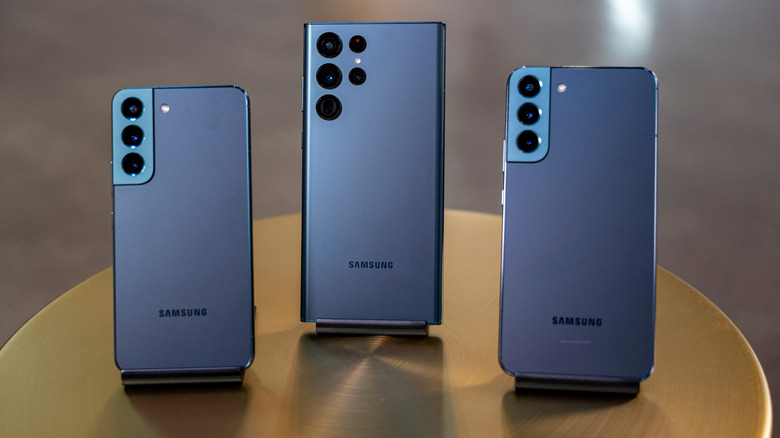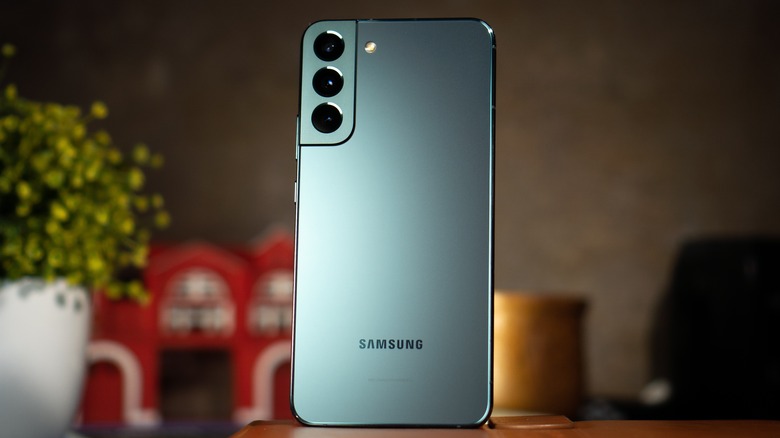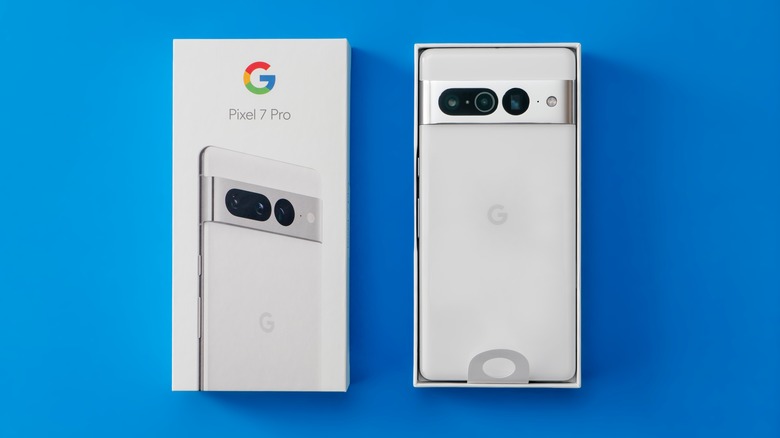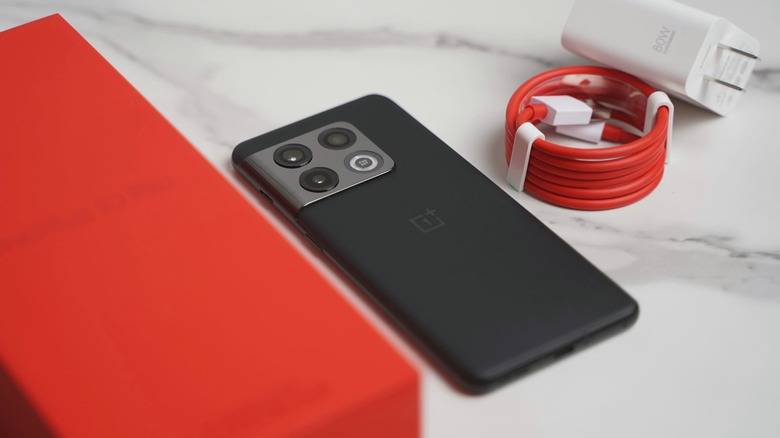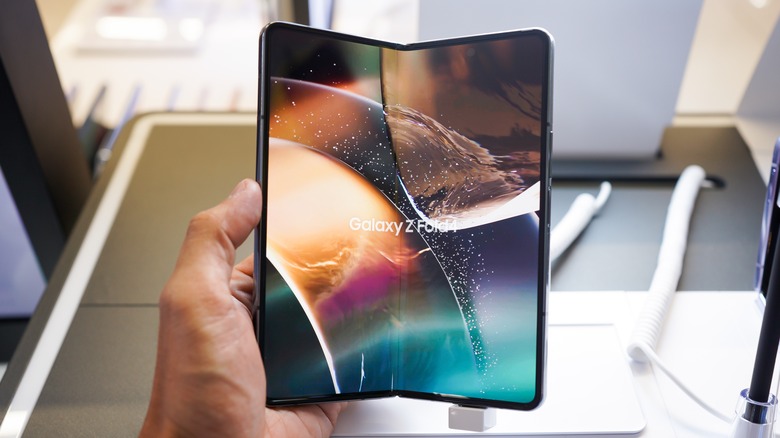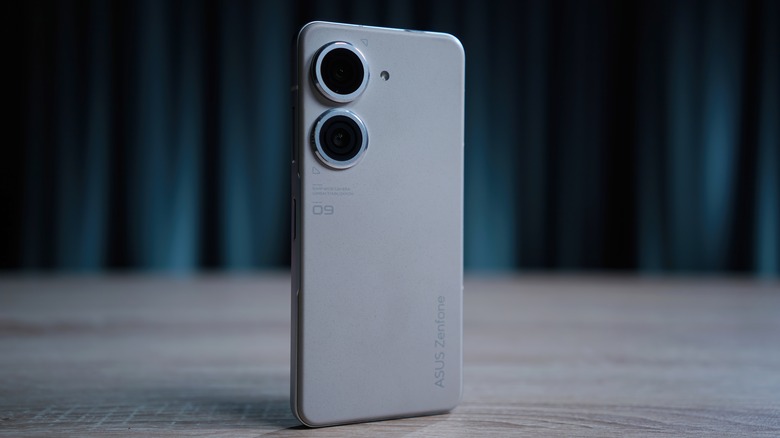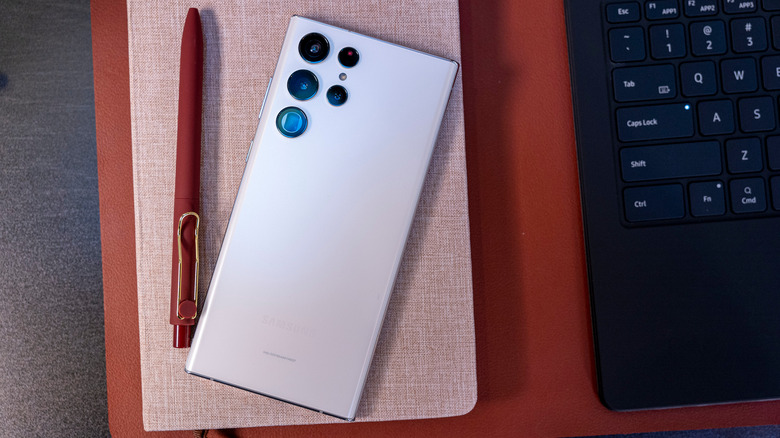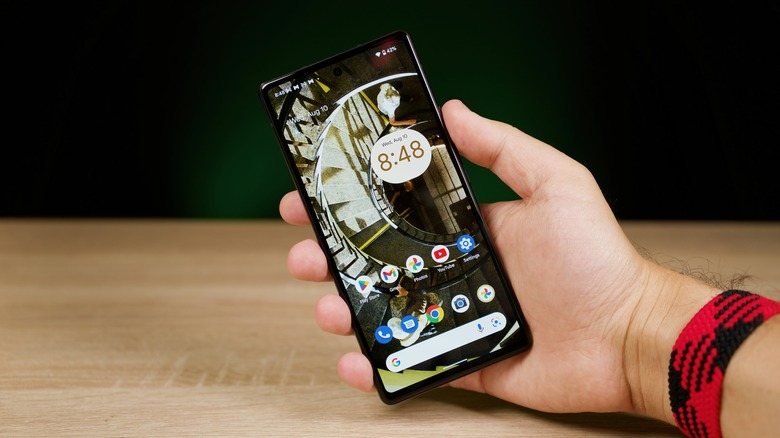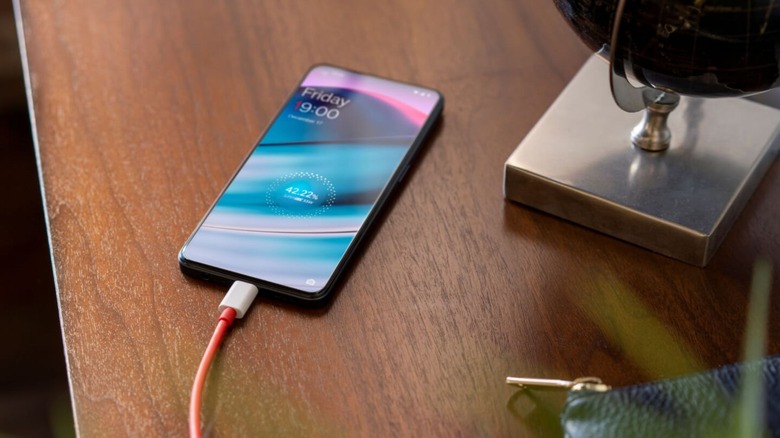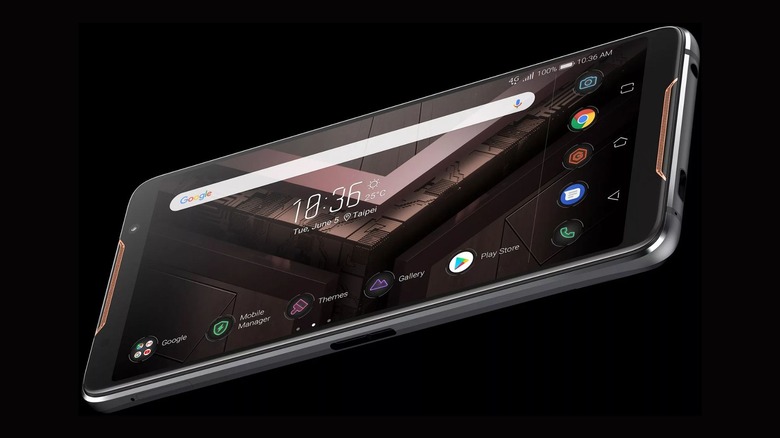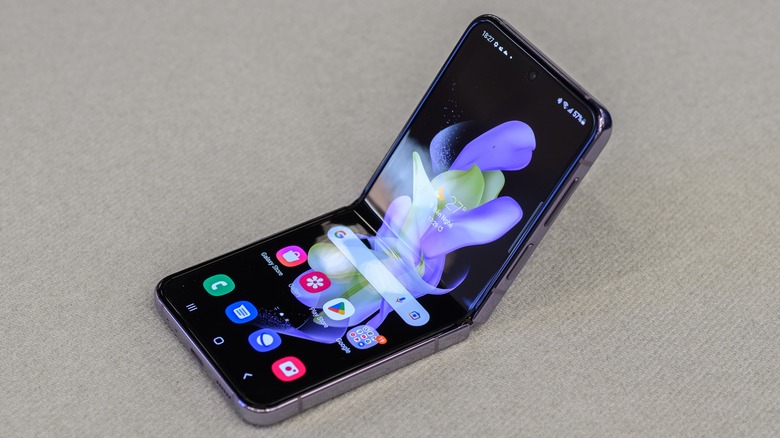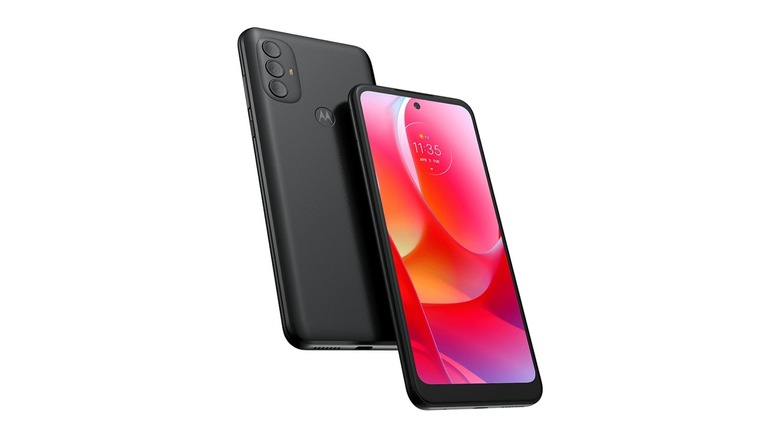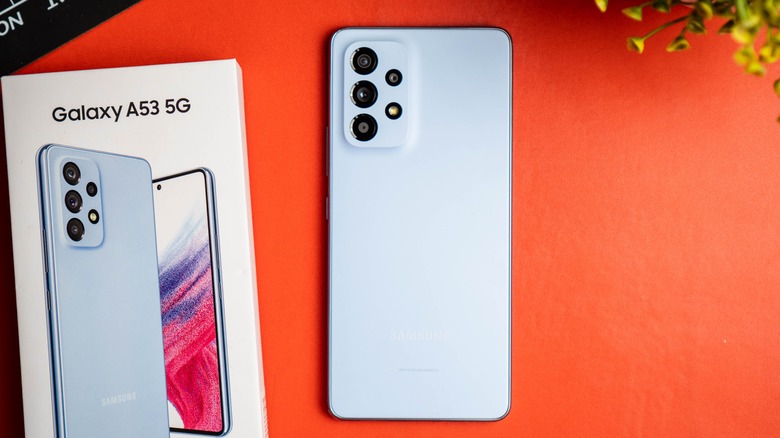The Best Android Phones Of 2022
Unless you're going on a digital detox retreat, you probably have a smartphone on you at all times. People don't just use phones for texting and calling anymore. Now, practically your entire life is on your smartphone — a virtual calendar to keep up with birthdays and meetings, precious photo and video memories, mobile games to keep you entertained in waiting rooms — and so much more.
When you use a smartphone for multiple hours every single day, it's important to make the right choice when it comes to upgrading to a new phone. Even if you've already decided to invest in an Android phone instead an iPhone, there's still so much to consider when choosing between the best of the best Android phones currently released.
One of the most important things to think about when choosing your next smartphone is how you feel about your current smartphone. Are there features you hate? Or maybe a feature you can't live without? Considering this can help you greatly narrow your search. But without further ado, here are the best Android phones you can buy right now.
Samsung Galaxy S22 Plus
While Samsung is currently offering phones with better specs or unique features — like the S22 Ultra's camera setup or the attractive display on the Z Fold 4 — the best Android phone from the company for most people is the Galaxy S22 Plus. Though its camera setup isn't as impressive as the more expensive S22 Ultra, it still has a snazzy setup, with its 10-megapixel front camera, 50-megapixel main rear camera, 12-megapixel ultra-wide lens, and 10-megapixel telescopic lens with 3x optical zoom.
Inside, the S22 Plus boasts the super-fast Snapdragon 8 Gen 1 processor — which you'll see in most new Android phones — as well as 5G network tech, Bluetooth v5.2, and Wi-Fi 6E. You also have 8 gigabytes of RAM, a choice between 128 and 256 gigabytes for UFS 3.1 storage, an ultrasonic under-display fingerprint scanner, and a 4,500 mAh battery with fast charging and an intelligent adaptive use feature.
Despite the 8 gigabytes of RAM being on the lower end for modern Android phones, we note in our review that the performance is silky smooth with Android 12 and Samsung's proprietary One UI 4.1. Then, the 6.6-inch Infinity-O FHD+ Dynamic AMOLED 2X display looks stunning, and SlashGear found that despite the Full HD+ resolution being a little lower, it's still crisp with its 120Hz max refresh rate and 240Hz touch sampling rate. With a whopping 1,750 nits max brightness and Samsung's VisionBooster tech, you should be able to use your phone in bright sunlight with no issues.
Without trading in your old phone, an unlocked Samsung Galaxy S22 Plus starts at $999.99, and you can find it in four colors: Pink Gold, Phantom White, Phantom Black, and Green. If you buy directly through Samsung's website, there are three extra colors to choose from: Graphite, Violet, and Sky Blue.
Google Pixel 7 Pro
The Google Pixel line of smartphones is known for having impressive cameras, awesome security features, and an intuitive user interface. Right now, the Pixel 7 Pro is the best phone you can buy from Google.
For selfies, the Pixel 7 Pro's 10.8-megapixel front camera helps you look great with fixed focus and an ultra-wide field of view. In the back, there's a 50-megapixel Octa PD Quad Bayer wide camera, a 12-megapixel ultra-wide camera with autofocus, and a 48-megapixel Quad Bayer telephoto camera with 5x optical zoom and up to 30x Super Res Zoom. With a laser detect autofocus (LDAF) sensor, optical and electronic image stabilization on the wide and telephoto cameras, and a ton of features and photo modes within the camera app, it's nearly impossible to take a bad photo on this Android phone.
When you flip through the awesome photos you take, it'll feel smooth and seamless on the 6.7-inch QHD+ LTPO OLED display with a 120Hz refresh rate and up to 1,500 nits max brightness. Beneath the display, you'll find a fingerprint sensor, 12 gigabytes of RAM, either 128, 256, or 512 gigabytes of UFS 3.1 storage, and a Google Tensor G2 and Titan M2 security coprocessor running the show. Then, it has support for Wi-Fi 6E, 5G network tech, and Bluetooth v5.2 with dual antennas for a better connection and overall quality.
Its massive 5,000 mAh battery easily lasts beyond 24 hours, and can even last up to 72 hours with Extreme Battery Saver turned on. With its fast-charging 30W USB-C charger with USB-PD 3.0 — sold separately, like most power bricks — you can get up to a 50% charge in only 30 minutes. The Google Pixel 7 Pro comes in three gorgeous colors — Hazel, Snow, and Obsidian — and starts at $899 for the lowest storage option.
OnePlus 10 Pro
Samsung and Google are almost always on top of the competition when it comes to Android phones, but OnePlus has made quite a name for itself. Its latest flagship — the OnePlus 10 Pro — holds its own against the latest models from Samsung and Google, and costs slightly less at the same time, starting at $799.
There are a few different ways to customize your OnePlus 10 Pro, so that price can easily take a hike, but you'll get stronger phone specs in exchange. You can choose between 8 or 12 gigabytes of RAM, 128 or 256 gigabytes of UFS 3.1 2-LANE storage, and then between two sleek colors: Volcanic Black or Emerald Forest. No matter how much RAM or storage you spring for, all 10 Pro phones include a Snapdragon 8 Gen 1 processor with an Adreno 730 GPU and an X65 5G chipset.
All available versions also include the OxygenOS based on Android 12, a 6.7-inch AMOLED LTPO display with a 3216x1440 pixel resolution and 120Hz fluid refresh rate, and the same camera setup. The 32-megapixel front camera has a Sony IMX 615 sensor and a fixed-focus autofocus feature. Turning the phone around, there's a 48-megapixel main camera with a Sony IMX789 sensor and multi-autofocus, a 50-megapixel ultra-wide camera with a JN1 sensor, and an 8-megapixel telephoto camera.
It has a 5,000 mAh battery that's equipped with speedy 65W SUPERVOOC charging, though you'll need to purchase the proper power brick separately and 50W fast wireless charging.
Samsung Galaxy Z Fold 4
Mobile phones used to be huge, and then progressively got smaller, but the Galaxy Z Fold 4 from Samsung is bringing back "big phone" vibes in a more attractive way. When it's folded, the Z Fold 4 has a 6.2-inch HD+ Dynamic AMOLED 2X Infinity-O display. The phone's unfolded display is even more impressive, with a 7.6-inch screen and Dynamic AMOLED 2X Infinity Flex tech. Both displays have Samsung's beautiful 120Hz adaptive refresh rate.
The only customizable option for the Galaxy Z Fold 4 is with UFS 3.1 storage, and your choices include 256 or 512 gigabytes or 1 terabyte. Every Z Fold 4 is equipped with a Snapdragon 8+ Gen 1 processor, 12 gigabytes of RAM, 5G network technology, Wi-Fi 6E, Bluetooth v5.2, a 4,400 mAh battery with wireless PowerShare tech, an S Pen, an ultrasonic fingerprint scanner on the phone's side, and the same stunning camera setup.
On the Galaxy Z Fold 4, there's a 10-megapixel cover camera, a 4-megapixel under-display front camera, and a rear camera setup with three sensors. You'll find a 50-megapixel wide camera, a 12-megapixel ultra-wide camera, and a 10-megapixel telephoto lens with 3x optical zoom and up to 30x Space Zoom. Despite the Z Fold 4's camera specs lacking a bit in comparison to other Samsung flagships, you'll still have access to handy features like flaw detection and scene optimizer.
Unless you can find it on sale, an unlocked Samsung Galaxy Z Fold 4 costs a steep $1,919.99 with no trade-in. Available colors are limited to Graygreen, Beige, and Phantom Black — or an exclusive Burgundy shade, if you order specifically through Samsung's website.
ASUS Zenfone 9
If you're looking for a smartphone that fits comfortably in your hand, the Zenfone 9 from ASUS is the best small Android phone and makes one-handed use super easy. It has a 5.9-inch Samsung AMOLED display with a 120Hz refresh rate, 2400x1080 pixel resolution, and 1,100 nits max brightness. Then, there's a beefy 4,300 mAh battery that'll last you all day and charge quickly with the 30W HyperCharge adapter that's actually included with your phone purchase — how rare!
The ASUS Zenfone 9 boasts the Snapdragon 8+ Gen 1 processor seen in many new Android phones, paired with the Adreno 730 GPU and running Android 12. Then, there's a choice between 8 or 16 gigabytes of RAM, 128 or 256 gigabytes of UFS 3.1 storage, and four colors, including Sunset Red, Midnight Black, Moonlight White, and Starry Black. With the lowest storage and memory options, the Zenfone 9 starts at $699.99.
Despite its lower price tag, selfies will come out crisp with the Zenfone 9's 12-megapixel front camera with Sony's IMX663 flagship sensor. The phone's rear camera setup lacks a telephoto lens but is still more than capable of awesome photos with its 50-megapixel main camera with a Sony IMX766 sensor and 12-megapixel ultra-wide camera with a Sony IMX363 sensor.
The Zenfone 9 puts a special emphasis on its audio system, with multi-magnet stereo speakers equipped with Qualcomm's WSA8835 smart amplifiers and Dirac HD sound. This speaker setup results in a louder, deeper, and less distorted overall sound. You'll also find support for Wi-Fi 6/6E, Bluetooth v5.2, and 5G networks.
Samsung Galaxy S22 Ultra
There's not much difference between Samsung's Galaxy S22 Plus and its S22 Ultra — except for the camera setup. Unless you're looking to take some stunning pictures with your smartphone, the extra cost of the Galaxy S22 Ultra just isn't worth it. The S22 Ultra starts at $1,199.99, and the price goes up if you want more RAM or storage.
On the Galaxy S22 Ultra's front, there's a 40-megapixel camera for gorgeously sharp selfies. In the back, there's a four-camera setup that's perfect for any type of photo or video you're trying to shoot. You'll find a 108-megapixel main wide camera, a 12-megapixel ultra-wide camera, a 10-megapixel Tele lens with 3x Optical Zoom, and a 10-megapixel Tele lens with 10x Optical Zoom. With special Samsung camera features like flaw detection, scene optimizer, and Single Take, your pictures will look professional.
Inside, the S22 Ultra is decked out with the latest Snapdragon 8 Gen 1 processor, either 8 or 12 gigabytes of RAM, an ultrasonic fingerprint scanner, a 5,000 mAh battery capable of wireless PowerShare and super fast charging, 5G network technology, and a beautiful 6.8-inch Infinity-O HD+ Dynamic Amoled 2x display with a 120Hz adaptive refresh rate and Vision Booster tech that makes it easy to see your screen in sunlight. For storage options, you can splurge on a huge 1 terabyte option, or stick with 128, 256, or 512 gigabytes of storage.
The S22 Ultra is the first Galaxy S phone to ever have a built-in S Pen — which is just Samsung's fancy way of saying "stylus" — and it works amazingly. Its boxy design is reminiscent of the Note devices and comes in four colors everywhere — Phantom Black, Phantom White, Burgundy, and Green — and three colors exclusively on Samsung's website — Graphite, Sky Blue, and Red.
Google Pixel 6a
If you like the idea of owning a Pixel phone but want to save quite a bit of money, the Google Pixel 6a just might be the perfect phone for you. At $449, the Pixel 6a is one of the most affordable Android phones you can get right now, and it has specs that are powerful enough to handle streaming media, browsing the web, and using call and text functions — but it does lack wireless charging capabilities.
The Pixel 6a has a Google Tensor processor identical to the one in the Pixel 6 Pro, as well as a Titan M2 security coprocessor and all the same awesome data safety features as the Pixel 7 Pro, like end-to-end security, camera, and mic toggles, and protection against phishing and malware. Then, there are 128 gigabytes of UFS 3.1 storage, 6 gigabytes of RAM, a 6.1-inch FHD OLED display with a 60Hz max refresh rate, an under-display fingerprint sensor, and a 4,410 mAh battery with a possible battery-life of up to 72 hours with Extreme Battery Saver turned on.
Google's budget-friendly Pixel 6a supports Wi-Fi 6/6E, Bluetooth v5.2, and 5G network tech, and comes in three unique colors: Sage, Chalk, and Charcoal. The front and rear cameras aren't incredibly impressive on the 6a, but that's to be expected at this price, and you can still take some pretty decent pictures despite this. The 8-megapixel front camera has fixed focus and a wide 84-degree field of view. In the back, there's a 12.2-megapixel wide camera with Super Res Zoom up to 7x, and the 12-megapixel ultra-wide camera is equipped with optical and electronic image stabilization.
OnePlus Nord N20 5G
Though flagship phones from OnePlus have gotten much more expensive since its first phone was released, the company still makes phones that are really affordable and pack a powerful punch. The Nord N20 5G from OnePlus nails the basics, but priced at only $299, don't expect it to play demanding mobile games or run as smoothly as smartphones that cost triple the price. There's only one color choice with this phone: Blue Quantum.
Inside, you'll find 6 gigabytes of LPDDR4X — a lower standard than the LPDDR5 RAM found in most Android phones nowadays — and 128 gigabytes of UFS 2.2 storage, though you can add up to 512 gigabytes of extra storage via a microSD card. Qualcomm's Snapdragon 695 processor is paired with the Adreno 619 GPU, and the OnePlus Nord N20 5G supports 5G network tech, as its name implies, as well as Bluetooth v5.1, Wi-Fi 5, and OxygenOS based on Android 11.
Despite its low price tag, the Nord N20 has a beefy 4,500 mAh battery with the famous SUPERVOOC fast charging from OnePlus — the 33W power brick is sold separately, of course — and an impressive camera setup. There's a 16-megapixel selfie camera and a 64-megapixel main rear camera, along with a 2-megapixel macro lens and a 2-megapixel monochrome lens. Then, the 6.43-inch AMOLED capacitive display has a 1080x2400 pixel resolution and an under-display fingerprint scanner.
ASUS ROG Phone 6
While the term "gaming phone" might still be a bit cringy, there's no question that phones made specifically for mobile gaming are often performance beasts, whether you intend to play games or just use it as a regular old phone. The ROG Phone 6 from ASUS comes in two colors — Phantom Black and Storm White — and pricing starts at $999.99, depending on how much storage and memory you need. You can choose between 8, 12, and 16 gigabytes of RAM, and between 256 and 512 gigabytes of UFS 3.1 storage.
ASUS ROG Phone 6 was released with a Qualcomm Snapdragon 8+ Gen 1 processor and Adreno 730 GPU, Bluetooth v5.2, integrated Wi-Fi 6E support, 5G network tech, and a high-capacity 6,000 mAh battery with Quick Charge 5.0 tech and an included 65W power adapter. The 6.78-inch Samsung AMOLED display has a 165Hz refresh rate, up to 720Hz touch sampling rate, and 23-millisecond touch latency.
To optimize the mobile gaming experience, the ROG Phone 6 has a GameCool 6 thermal system to keep everything cool from three different directions, an AirTrigger 6 system for easier in-game control, and a proprietary Armoury Crate app where you can monitor absolutely everything you need to. There's also a high-end X-axis linear motor beneath the surface to make games more immersive, with up to 130Hz of vibration frequency.
Despite the huge focus on gaming-specific features, the ROG Phone 6 doesn't skimp on its camera setup. For selfies, you've got a 12-megapixel camera, and for all other pictures, there's a 50-megapixel main camera with a Sony IMX766 sensor, a 13-megapixel ultra-wide camera, and a 5-megapixel macro lens for closeups.
Samsung Galaxy Z Flip 4
Samsung's Galaxy Z Flip 4 brings back all the nostalgia surrounding flip phones but majorly updates internal specs and modernizes the design and form factor. This pocket-sized phone has a full-size 6.7-inch FHD+ Dynamic AMOLED 2X Infinity Flex display with a 120Hz adaptive refresh rate, and then a smaller 1.9-inch Super AMOLED display you can use when the phone is closed.
The folding hinge is protected with lightweight Armor Aluminum, and the front and back covers are made of tough Corning Gorilla Glass Victus+, so though a folding glass flip phone might feel fragile, it can withstand quite a bit. Inside the Galaxy Z Flip 4, there's a Snapdragon 8+ Gen 1 processor, 8 gigabytes of RAM, options of 128, 256, or 512 gigabytes of storage, and a 3,700 mAh battery with wireless PowerShare capabilities. Compared to other phones from Samsung, the battery life on this phone is poor, but that was one of the only flaws we noted in our Galaxy Z Flip 4 review.
There's nothing super impressive about the Z Flip 4's camera setup, but it's passable and takes pretty decent photos. And let's be honest — if you're buying this phone, you're probably buying it for the awesome folding design and not the cameras. There's a 10-megapixel front camera, and two cameras in the rear, including a 12-megapixel wide camera and a 12-megapixel ultra-wide lens with 10x digital zoom.
The phone has a capacitive ultrasonic fingerprint scanner and supports 5G network technology, Wi-Fi 6, and Bluetooth v5.2. Starting at $1,059.99, the Galaxy Z Flip 4 comes in quite a few fun colors, including Bora Purple, Graphite, Pink Gold, and Blue. Then, if you order through Samsung's website and live in a compatible country, you'll have access to the Bespoke Edition Colors.
Moto G Power
Despite having lower specs than a lot of the phones on this list, the Moto G Power is still one of the best Android phones because of its incredible battery life and super affordable price tag. At $199.99, Moto's G Power has a 5,000 mAh battery that can last up to three days and comes with a 10W rapid charging power brick. The G Power's battery life is so long because the specs inside aren't overly power-hungry.
That said, you're still able to carry out many everyday smartphone functions like calling, texting, navigating, browsing the internet, and streaming media. There's a MediaTek Helio G37 processor, 4 gigabytes of RAM, and a choice between 64 or 128 gigabytes of storage, though you can add an extra 512 gigabytes with a microSD card. The 6.5-inch Max Vision IPS TFT LCD display has a 1600x720 pixel resolution and a surprisingly speedy 90Hz refresh rate.
Moto's G Power offers support for Bluetooth v5.0, Wi-Fi 5, and 4G/3G networks, all of which are expected at this price point. If you want the latest 5G tech, you'll need to bump up your budget a few hundred bucks. The Moto G Power also doesn't offer NFC tech and uses the Android 11 operating system, with the potential to upgrade to Android 12 at some point in the future.
The G Power's camera setup isn't amazing but it's a great value. There's an 8-megapixel front camera and a 50-megapixel camera in the back, along with a 2-megapixel macro lens and a 2-megapixel depth lens. It's also worth mentioning that this phone does have a fingerprint scanner and a 3.5mm headphone jack. Then, you have a choice between two colors: Dark Grove and Ice Blue.
Samsung Galaxy A53
Samsung's Galaxy A53 5G phone strikes the perfect balance between modern features — like 5G network technology, NFC, Bluetooth v5.1, and Wi-Fi 5 support — and affordability, with the phone's base price starting at $449.99. The Galaxy A53 also runs the latest Android 12 operating system with Samsung's One UI 4.1, has a secure fingerprint sensor to easily unlock the phone, and boasts a 6.5-inch Super AMOLED FHD+ display.
It has a large 5,000 mAh battery that is equipped with adaptive technology that learns how you typically use your phone and optimizes your battery usage. There are no customizable options with the Galaxy A53's RAM and storage — everyone gets the same Awesome Black color and spec configuration, with 6 gigabytes of RAM, a 2.4GHz octa-core processor, and 128 gigabytes of built-in storage, though you can buy a microSD card to add up to one extra terabyte.
Most affordable Android phones don't have a great camera system, but Samsung doesn't disappoint with the Galaxy A53's cameras. The front 32-megapixel doesn't have autofocus or optical image stabilization (OIS), but it creates a sharp image if you're able to keep your phone still manually. Then, the 64-megapixel main rear camera has autofocus and OIS, and is paired with a 12-megapixel ultra-wide camera and a 5-megapixel camera for depth and macro capabilities and digital zoom up to 10x.
